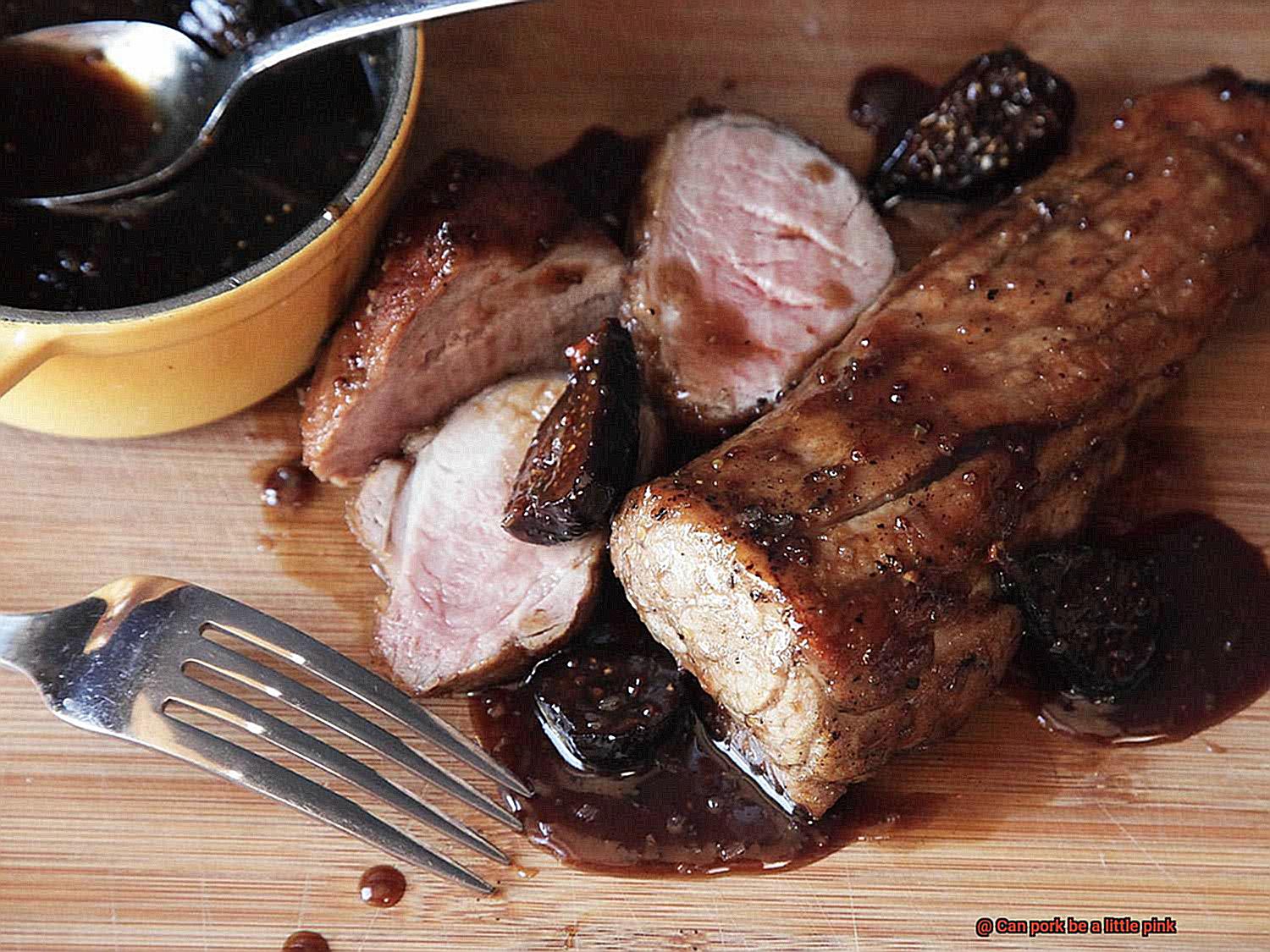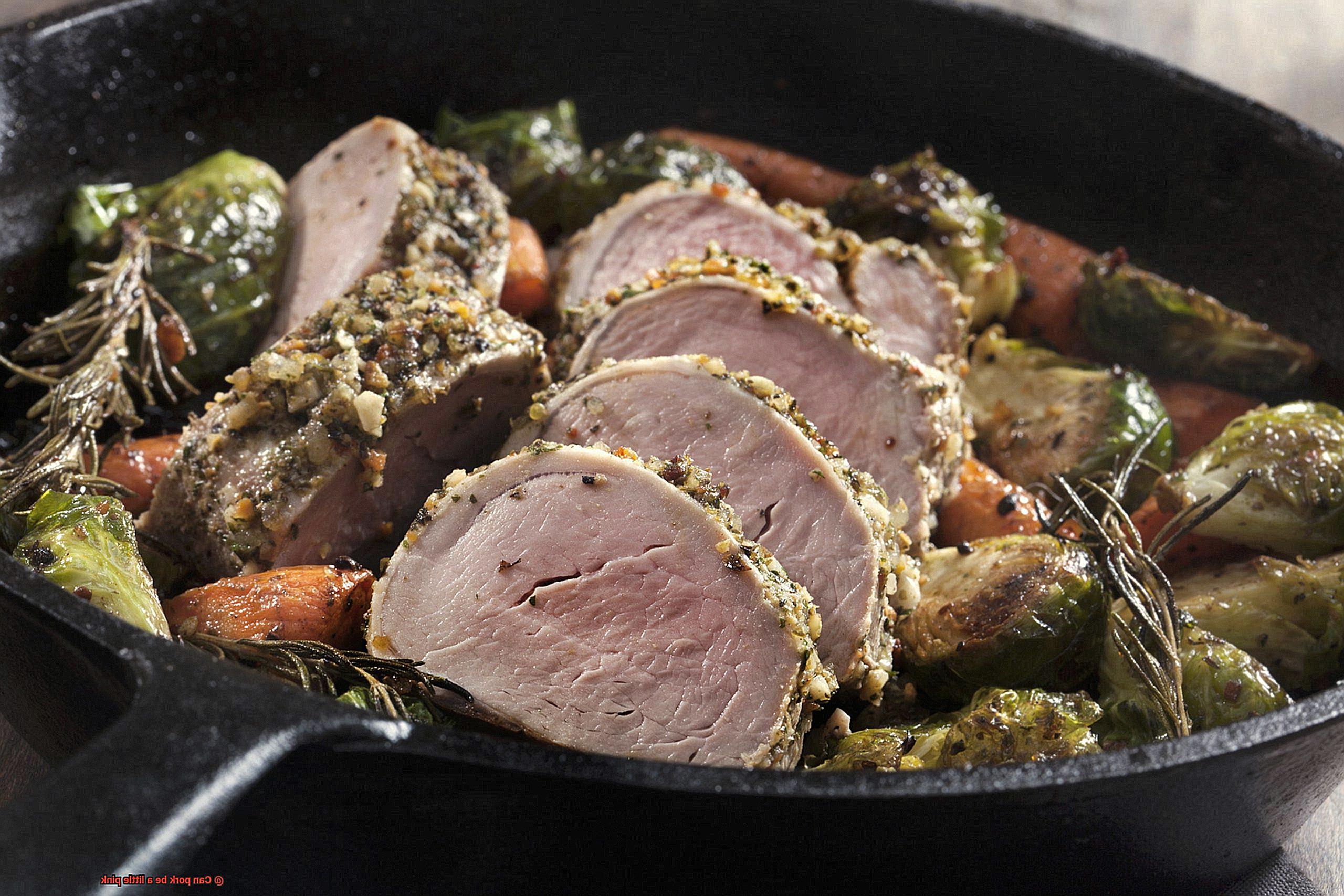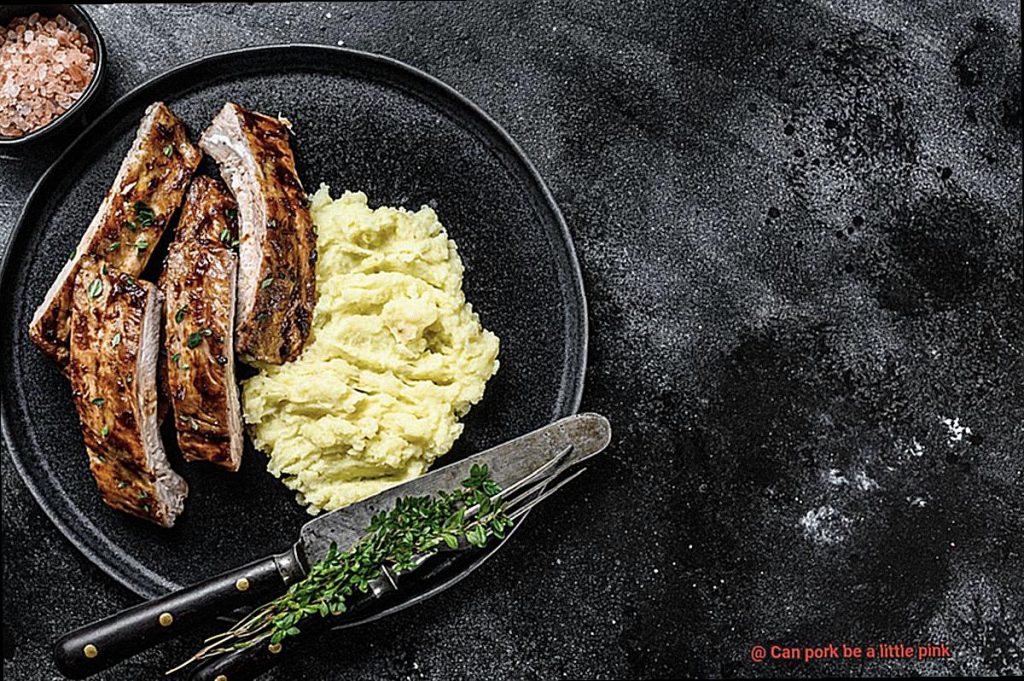Pork is a versatile and delicious meat that can be prepared in countless ways. However, many people are intimidated by cooking pork due to the fear of undercooking it. For years, the USDA recommended cooking pork until it reached an internal temperature of 160°F, which often resulted in dry and overcooked meat. But times have changed, and recent research has shown that pork can be safely consumed when cooked to an internal temperature of 145°F.
If you’ve ever been served a pink or slightly undercooked pork chop at a fancy restaurant, you may have felt uneasy about eating it. But fear not. Pork that’s a little pink is perfectly safe to eat. In fact, it’s often more flavorful and juicy than its well-done counterpart.
In this blog post, we’ll explore the topic of ‘Can pork be a little pink,’ debunk some common misconceptions about pork cooking, and provide you with expert tips on how to cook pork safely and deliciously. So whether you’re grilling up some ribs for a summer BBQ or preparing a hearty pork roast for dinner, you’ll know exactly how to cook your pork to perfection without any worries. Stay tuned.
Contents
What is the USDA’s Recommended Internal Temperature for Pork?
The USDA recommends cooking whole cuts like pork chops, roasts, and tenderloins to an internal temperature of 145°F (63°C) with a three-minute rest time. This temperature ensures that harmful bacteria such as Salmonella and E. coli are eliminated, making the meat safe for consumption. To determine the pork’s temperature, using a meat thermometer is essential.
It’s important to note that pork doesn’t have to be cooked until it’s no longer pink in the center. Overcooking pork can result in dry and tough meat. As long as the internal temperature reaches 145°F, your pork can still have a slight pink color in the center. This is contrary to popular beliefs.
That being said, ground pork must always be fully cooked to an internal temperature of 160°F (71°C) to ensure food safety. The grinding process increases the risk of bacterial contamination, so it’s crucial to make sure ground pork is fully cooked.
Different cuts of pork may require different cooking times and temperatures, so it’s essential to refer to a reputable cooking guide or recipe for specific instructions. Using a meat thermometer will ensure that your pork is cooked thoroughly, reducing the risk of foodborne illnesses.
Can Whole Cuts of Pork Be Cooked to a Pink Center?

Well, it’s time to toss that habit out the window. As an expert on the subject, I can confidently tell you that whole cuts of pork, such as pork loin or pork chops, can be cooked to a pink center and still be safe to eat.
Thanks to advancements in food safety and changes in pig farming practices, the USDA updated their guidelines in 201The new guideline states that whole cuts of pork can be cooked to an internal temperature of 145°F (63°C), followed by a three-minute rest time, resulting in a juicy and flavorful meal without compromising safety.
But why the change? The risk of trichinosis, a foodborne illness caused by a parasite sometimes found in pork, has significantly decreased over the years. Additionally, modern pig farming practices have resulted in leaner cuts of pork that can easily become dry and tough if overcooked.
It is essential to note that this guideline only applies to whole cuts of pork and not ground pork or any type of raw sausage. To ensure safety, ground pork and sausage should always be cooked until there is no pink remaining, and the internal temperature reaches at least 160°F (71°C).
Whether you prefer your pork fully cooked or with a pink center, it’s all about personal preference. However, cooking whole cuts of pork to 145°F (63°C) with a three-minute rest time offers an excellent option for those who prefer a juicier and more flavorful meal.
Is Ground Pork Safe to Eat If It is Slightly Pink?
You may have wondered whether it’s safe to eat if it’s slightly pink in the middle. As an expert on the subject, I’m here to share some important information with you.
First things first, it’s essential to note that pork used to be recommended to be cooked to an internal temperature of 160°F (71°C) to ensure that any potential harmful bacteria are destroyed. However, the USDA has recently lowered its recommended cooking temperature for pork to 145°F (63°C), as long as it is held at that temperature for at least three minutes before being removed from the heat source. While this is good news for pork chops or roasts, it doesn’t apply to ground pork.
The reason for this is that ground meat has a larger surface area, which means any bacteria present on the surface can easily be mixed throughout the meat during the grinding process. Additionally, ground pork may contain other types of bacteria, such as Listeria or Campylobacter, which can cause serious illness if consumed. These bacteria can survive at lower temperatures than Salmonella or E. coli, so cooking ground pork until it reaches an internal temperature of 160°F (71°C) is still recommended to ensure their destruction.
So, is ground pork safe to eat if it’s slightly pink? The answer is no. Ground pork should always be cooked thoroughly and not served if it’s still pink in the middle. But don’t worry, cooking ground pork doesn’t have to be a complicated process. Here are some tips:

- Use a meat thermometer: The most accurate way to check the internal temperature of ground pork is by using a meat thermometer. Insert the thermometer into the thickest part of the meat and make sure it reads at least 160°F (71°C).
- Cook on medium-high heat: Cook ground pork on medium-high heat to ensure that it’s cooked thoroughly. This will help prevent the meat from drying out while ensuring that it’s safe to eat.
- Don’t overcrowd the pan: Overcrowding the pan can cause the meat to steam instead of brown, which can result in uneven cooking and potentially harmful bacteria.
How to Properly Handle and Cook Pork
Pork is a delicious and popular meat, but it can also be a source of harmful bacteria if not handled and cooked properly. To avoid foodborne illness, it is important to take precautions when handling and cooking pork. Here are some tips to help you do just that:
Wash Your Hands
Always wash your hands with soap and water before and after handling raw pork. This simple step can prevent the spread of harmful bacteria.
Sanitize Surfaces

Any surfaces or utensils that come into contact with raw pork should be thoroughly cleaned and sanitized before and after use. This includes cutting boards, knives, and countertops.
Keep it Cold
Raw pork should always be kept refrigerated at or below 40°F until ready to cook. This will slow the growth of harmful bacteria.
Use a Meat Thermometer
To ensure that pork is cooked to a safe internal temperature, use a meat thermometer to check the temperature in the thickest part of the meat. Whole cuts of pork should reach 145°F, while ground pork should reach 160°F.
Don’t Rely on Color
While some people may prefer their pork with a slightly pink center, this can be risky as harmful bacteria can still be present in undercooked meat. Always use a thermometer to check for doneness instead of relying on color.
Cook Thoroughly
To avoid foodborne illness, it is essential to cook pork all the way through to a safe internal temperature. This will also ensure that the pork is tender and juicy.
The Dangers of Undercooked or Raw Pork
Pork is a beloved protein source for many, but the dangers of consuming undercooked or raw pork cannot be ignored. It’s important to handle and cook pork properly to avoid serious health risks.
One major concern with undercooked or raw pork is the presence of harmful bacteria like Salmonella, E. coli, and Listeria. These bacteria can cause foodborne illnesses if not cooked thoroughly. Symptoms can range from mild to severe, including nausea, vomiting, stomach cramps, and diarrhea. Some individuals, such as pregnant women, young children, and those with weakened immune systems, are at higher risk of these dangers.
Another danger of undercooked or raw pork is the presence of Trichinella spiralis, a parasite that can cause trichinosis. This parasite is found in the muscle tissue of infected animals and can be transmitted to humans who consume undercooked or raw pork. Symptoms of trichinosis include fever, muscle pain, swelling around the eyes, and in severe cases, heart and respiratory failure.
Thankfully, there are steps you can take to prevent these dangers. The USDA recommends cooking pork to an internal temperature of 145°F followed by a three-minute rest time before cutting or consuming. This temperature ensures that harmful bacteria and parasites are destroyed. Additionally, it’s important to handle pork properly by washing your hands before handling it and sanitizing all surfaces that come into contact with it. Refrigerate pork promptly after purchase and use a meat thermometer to ensure that it has reached the proper internal temperature.
Tips for Cooking Pork Safely
Cooking pork can be a delicious and enjoyable experience, but it’s crucial to prioritize safety to avoid foodborne illnesses. Here are five tips for cooking pork safely:
Tip 1: Use a Meat Thermometer
One of the most important aspects of cooking pork safely is ensuring that it is cooked to the appropriate internal temperature. Using a meat thermometer is the only way to accurately determine if the pork has reached a safe temperature. The USDA recommends cooking pork to an internal temperature of 145°F (63°C) for at least three minutes before consuming.
Tip 2: Avoid Relying on Color
It’s essential to avoid relying on color alone when determining if your pork is fully cooked. Just because the meat looks done on the outside doesn’t mean it’s safe to eat. Always use a meat thermometer to check the internal temperature of your pork.
Tip 3: Let it Rest
Allowing your pork to rest for at least three minutes after reaching the recommended internal temperature is crucial for a juicier and more flavorful cut of meat. This also ensures that any remaining bacteria in the meat are destroyed by the heat.
Tip 4: Don’t Cross-Contaminate
Cross-contamination is a significant concern when handling raw pork. To avoid spreading harmful bacteria, keep raw pork separate from other foods and use separate cutting boards, utensils, and plates for raw and cooked pork. Always wash your hands thoroughly with soap and water after handling raw pork.
Tip 5: Marinate Before Cooking
Marinating your pork before cooking can add flavor and tenderize the meat, but it can also help kill any bacteria on the surface of the meat. However, be sure to discard any leftover marinade that has come into contact with raw pork to prevent cross-contamination.
How to Tell When Your Pork is Done Cooking
Cooking pork can be a little intimidating for some because of the risk of foodborne illnesses. But with proper cooking techniques and knowing how to tell if your pork is done, you can enjoy a delicious and safe meal. Here are five sub-sections that will help you understand how to tell when your pork is done cooking.
Use a Meat Thermometer
Using a meat thermometer is the most accurate way to determine if your pork is fully cooked. Make sure to insert the thermometer into the thickest part of the meat, making sure not to touch any bones. The USDA recommends cooking pork until it reaches an internal temperature of 145°F (63°C). This temperature will ensure that any harmful bacteria present in the meat has been destroyed.
Check the Juices
Another way to tell if your pork is done cooking is by checking its juices. Fully cooked pork should have clear juices that run from the meat when cut. If the juices are still pink or cloudy, this is a sign that the meat is not fully cooked. Make sure to let your pork rest for a few minutes before cutting into it, allowing the juices to redistribute.
Check the Texture
Fully cooked pork should be firm but still juicy, with a tender texture. If your pork is tough and dry, it’s likely overcooked. If it’s too soft and mushy, it’s likely undercooked. It’s important to find a balance between these two extremes for perfect pork.
Ground Pork
Ground pork should always be cooked until there is no pink remaining as this type of meat can harbor harmful bacteria if not cooked thoroughly. The internal temperature of ground pork should reach 160°F (71°C) to ensure food safety. Use a meat thermometer to check the internal temperature.
Lean Cuts
Some lean cuts of pork like loin or tenderloin may appear slightly pink even when fully cooked because they don’t have as much fat as other cuts. This is normal and safe as long as the internal temperature reaches 145°F (63°C). Use a meat thermometer and check for clear juices and a tender texture to ensure that your pork is fully cooked and safe to eat.
Alternatives to Grilling or Roasting Pork
Look no further, as there are numerous alternative cooking techniques that can elevate your pork to new heights.
First on the list is the slow-cooking method. While it may require a little patience, the end result is worth it. Season your pork with your favorite herbs and spices, place it in a slow cooker, and let it cook on low heat for several hours. The result? Tender, juicy meat that falls apart with ease.
Another option is pan-frying. This quick and easy method involves heating up some oil in a skillet, searing your pork on both sides until it’s cooked through, and enjoying a crispy exterior with a juicy center.
Lastly, don’t underestimate the power of baking. This versatile method involves seasoning your pork and placing it in a baking dish with some vegetables and broth or sauce. Cover the dish with foil and bake in the oven until the pork is cooked through. This technique is perfect for those who want a one-pot meal that’s easy to clean up.
Incorporating these alternative cooking methods into your repertoire can provide different textures and flavors to your pork dishes, adding a nice change of pace from traditional grilling or roasting. It’s important to note that regardless of the cooking method used, pork should always be cooked to an internal temperature of at least 145°F to ensure that it’s safe to eat.
H9d4uCanT-Y” >
Conclusion
To sum it up, the fear of serving undercooked pork is a valid concern for many home cooks. However, with advancements in farming practices and recent research, it’s been proven that pork can be safely consumed when cooked to an internal temperature of 145°F (63°C). This means that you can still enjoy a slightly pink center without compromising your health.
It’s worth noting that ground pork must always be fully cooked to an internal temperature of 160°F (71°C) due to the increased risk of bacterial contamination during the grinding process. You can ensure safety by using a meat thermometer, avoiding cross-contamination, and letting your pork rest after cooking.
If you’re looking for different ways to cook your pork dishes, there are various options like slow-cooking, pan-frying or baking that offer distinct textures and flavors. Regardless of your preferred method, prioritizing safety through proper handling and cooking techniques should remain at the forefront of your mind.
With this newfound knowledge on hand, you can confidently prepare delicious and safe pork dishes at home.






